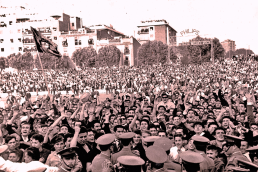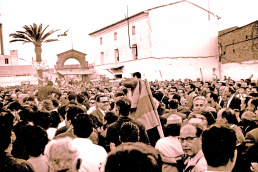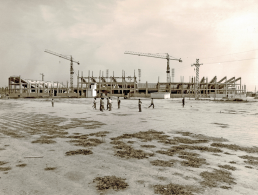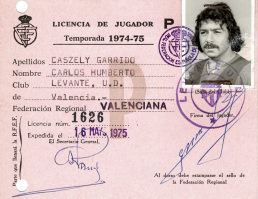Photograph of the fans celebrating the promotion in Vallejo 1963.
The dream of promotion materialized in June 1963. Levante beat Deportivo de La Coruña in an unforgettable knock-out round. The dream was not eternal. The end of the sixties coincided with the move to the Antonio Román Stadium, currently the Ciutat de València.
Photograph of the fans celebrating the promotion with the Portal de Vallejo in the background.
The rise to the elite division seemed an unrealizable fiction. The dream resisted, but the leap occurred in the 1962-1963 financial year after eliminating Deportivo de La Coruña in a historic double confrontation with a climax in the Vallejo fort. That day the palms thundered, despite the fact that the day dawned in the shadows following the death of Pope John XXIII. Antonio Román had ceded the presidency to José Navarro as a prologue to the arrival of Eduardo Clerigues as President, with Blas Escrig as the main figure in the management of the financial area.
The promotion to the First Division led to two unforgettable seasons as part of the experience in the highest category. There were prestigious victories against Barcelona (5-1 in Vallejo) and the city discovered a derby that time had rusted. In this framework it is possible to contextualize the call of Ernesto Domínguez to the Spanish National Team in a duel between La Roja and Belgium in Mestalla. Levante defended the tenth position in the table during their debut year, but returned to Second Division at the end of the 1964-1965 financial year after a disastrous clash against Málaga in the playoffs.
Construction of the Antonio Román Stadium, currently Ciutat de València.
In 1966 Antonio Román returned to the presidency of the Barça society. This second stage is linked to the construction of the Ciutat de València Stadium, inaugurated on 9th September 1969 as the Antonio Román Stadium. Levante and Valencia fought on their pitch recalling historical battles that evoked the premieres of the Campo de La Cruz or Mestalla in the twenties.
Levante came close to a return to the elite in the 1966-1967 season. However the economic problems lead to the sale of those players with greater projection. With the final departure of Wanderley or Domínguez, the trace of the squad who gained promotion in June 1963 was lost. The 1967-1968 season began with a heavy load motivated by a restructuring of the Silver category that engulfed Levante. A year later they returned to the Third Division and played their home matches at the Mestalla Stadium, courtesy of the Valencia board of directors.
Caszely license.
Manuel Grau Torralba is associated with the signing of Carlos Caszely. The president, since he took over the granota presidency in 1971, went in heavily in an attempt to claim the name of Levante and associate it with the Valencia environment. He devised the Costa de Valencia Trophy and nurtured the squad of players with experience in the national realm.
Grau Torralba was a man of action. He boosted relations with the press and shocked the transfer market in the summer of 1973 with the announcement of the hiring of Caszely. Levante had just returned to the Silver category after the promotion achieved by Juncosa. It was the first of two promotions celebrated by the president. However, the return to Primera, perhaps his great dream, did not materialize.
Caszely completed two seasons at Levante before emigrating to Espanyol for a succulent financial amount. The emergence of democracy did not bring significant changes in the sports section, but greatly accentuated the difficulties in a financial aspect. Levante was first to experience the recently inaugurated Second Division B in the 1977-1978 season. A year later the victory against Ibiza projected them towards the Silver category.



